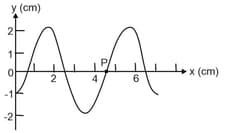A harmonic oscillator vibrates with amplitude of and performs oscillations in one minute. If the initial phase is and it starts moving away from the origin, then the equation of motion is:

Important Questions on Wave Motion
The displacement of a wave disturbance propagating in the positive direction is given by, at, and at, , where, and are in meter. The shape of the wave disturbance does not change during the propagation. What is the velocity of the wave?
A traveling wave pulse is given by, .
Here, and are in meter and is in second. In which direction and with what velocity is the pulse propagating? What is the amplitude of the pulse?
If at , a travelling wave pulse on a string is described by the function, where and are in meters and in seconds, what will be the wave function representing the pulse at time if the pulse is propagating along the positive -axis with speed ?
Consider a sinusoidal travelling wave shown in the figure. The wave velocity is .
Find,
(a) the frequency
(b) the phase difference between points which are apart.
(c) how long it takes for the phase at a given position to change by .
(d) the velocity of a particle at point at the instant shown.
The equation of a travelling wave is, .
Find,
(a) the wave velocity and
(b) the particle velocity at and .
Given, where, .
Transverse waves on a string have wave speed , amplitude and wavelength . The waves travel in the direction and at , the end of the string has zero displacement and is moving upwards.
(a) Write a wave function describing the wave.
(b) Find the transverse displacement of a point at at time, .
(c) How much time must elapse from the instant in part (b) until the point at has zero displacement?

